The American Cancer Society (ACS) this week called for millions more people who formerly smoked to be screened for lung cancer than it previously recommended. But while a University of Colorado Cancer Center member calls the news “exciting,” she said the overarching challenge is to get more people already eligible to be screened.
Nina Thomas, MD, assistant professor of pulmonary and critical care medicine at the CU School of Medicine and director of the lung nodule and lung cancer screening program, says that even with advances in lung cancer treatment, early detection is vital. Yet most people who should be screened aren't for a variety of reasons.
Previous ACS guidance advised that people with a history of smoking get a low-dose CT scan only if they quit more recently than 15 years ago. The ACS' updated screening guidelines – published Nov. 1 in CA: A Cancer Journal for Clinicians and on the society's website – say that how long ago someone quit should not be a factor in screening eligibility.
The society also said people who smoked 20 pack-years or more should be screened, rather than the higher threshold of 30 pack-years it previously recommended. (Pack-years are calculated by multiplying average packs smoked per day by total number of years smoked. For example, 10 pack-years is an average of one pack of cigarettes per day for 10 years.)
The ACS also expanded its advised age range for screening to ages 50 to 80 from the previous 55-74 age range.
Thomas walks us through the new ACS guidance and the need for screening generally in an interview.





.png)